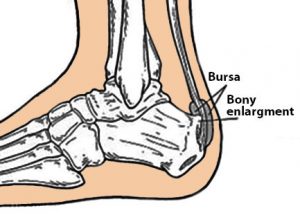Haglund’s Deformity
What is Haglund’s Deformity?

Haglund’s deformity is a bony enlargement that appears on the back of the heel, where the Achilles tendon is inserted.
The soft tissue near the Achilles tendon insertion can become irritated when the bony bump rubs against shoes.
This often may lead to retrocalcaneal bursitis, which is an inflammation of the bursa (the fluid filled sac at the back of your heel).
Haglund’s Deformity Causes
This condition is also referred to as “pump pump” because it often occurs in women who wear high heeled pump style shoes.
This kind of shoes and, in general, wearing shoes with a rigid back, can create a pressure that can contribute to aggravate the enlargement when walking.
Experts believe that Haglund’s deformity can happen to anyone, but you may be more at risk if you have also:
- High arches
- A tight Achilles tendon
- A tendency to walk on the outside of your heel.
What are the symptoms?
Haglund’s deformity can occur in one or both feet and the primary symptoms are:
- heel pain
- an enlarged bony prominence (bony bump) on the back of the heel
You may also notice swelling in the back of the heel (bursa) and redness near the inflamed tissue.
How is Haglund’s deformity diagnosed?
Symptoms may be similar to those associated with other foot complaints, such as Achilles tendonitis, so the orthopedic foot and ankle surgeon not only will examine the foot, but may also order x-rays, in addition.
X-rays may help evaluate the structure and shape of the heel bone and to determine the severity of the condition.
How is Haglund’s deformity treated?
Non surgical treatment
The treatment depends on the severity of the condition and it usually focuses on relieving pain and reducing the inflammation of the bursa.
Nonsurgical treatment can include:
- Ice (for 20 minutes and then wait at least 40 minutes before icing again)
- Nonsteroidal anti-inflammatory drugs (i.e. ibuprofen)
- Rest it is recommended, in particular, to avoid exercises that aggravate the condition, such as running and running uphill
- Stretching Exercises to relieve tension from the Achilles tendon
- Shoe modification (open-back shoes, heel pads, heel lifts)
- Physical therapy to reduce inflammation, such as ultrasound.
- Orthotic devices such as custom arch supports
Immobilization If the area is extremely inflamed, a custom-made soft cast or walking boot may be necessary to immobilize the area and allow it to heal.
Surgical Treatment
If none of the suggested nonsurgical methods provide pain relief, surgery may be recommended. Specially-trained foot and ankle surgeons can determine the procedure that is best suited to your case and surgically re-shape the heel bone.
Surgeon can perform a partial or total removal of the bony protrusion.
Endoscopic surgery has to be preferred because it is less invasive than conventional surgery. It uses smaller incisions and the recovery is usually shorter.
Patients must be aware that recovery from surgery can take several months.
Prevention
Here are some tips to prevent Haglund’s deformity:
- wear appropriate shoes (shoes with open backs, with soft, flexible backs)
- avoid shoes with a rigid heel back
- perform stretching exercises for the Achilles tendon to prevent it from tightening
- use arch supports
- avoid running uphill or on hard surfaces
How Prof. Portinaro treats Haglund’s deformity
Prof. Portinaro is one of the most qualified surgeons in the world for foot diseases and treatments.
In his long-running career he has been treating Haglund’s deformity in adult and children always with a non-operative approach and usually order X-rays to better evaluate the situation. But, when needed, he also performed surgeries on people affected by this condition through a minimally invasive approach as a day case.
His technique allow a deformity correction with a shorter recovery and better postoperative pain management.
